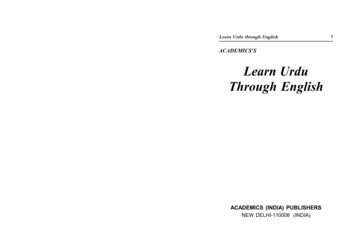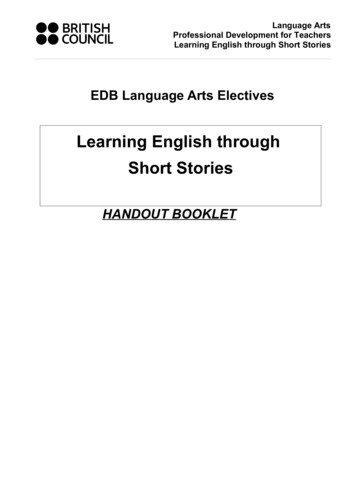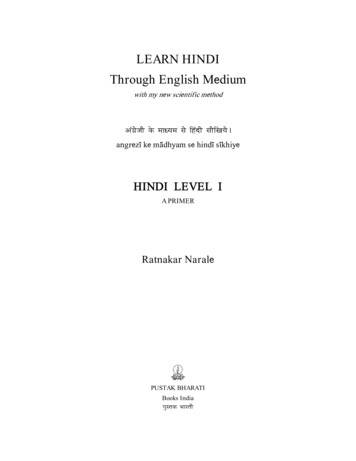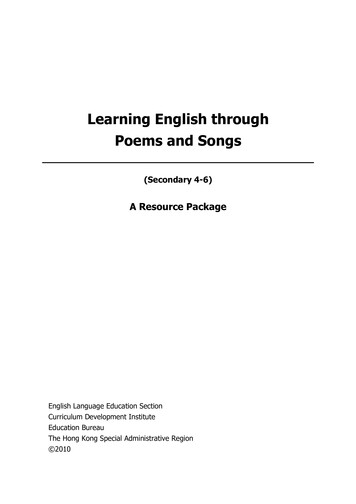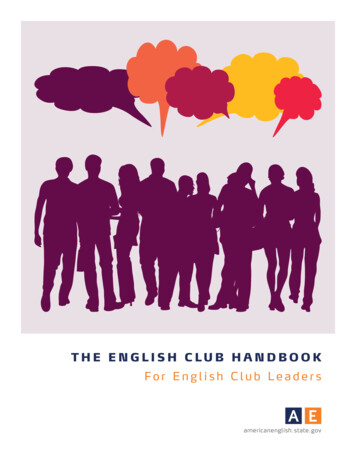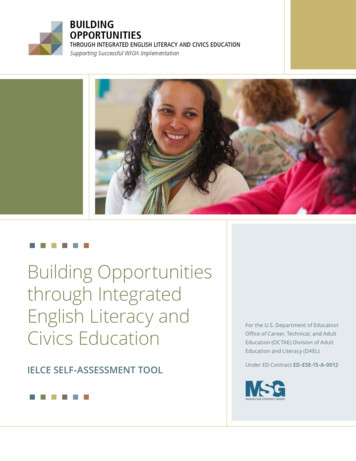
Transcription
Building Opportunitiesthrough IntegratedEnglish Literacy andCivics EducationIELCE SELF-ASSESSMENT TOOLFor the U.S. Department of EducationOffice of Career, Technical, and AdultEducation (OCTAE) Division of AdultEducation and Literacy (DAEL)Under ED Contract ED-ESE-15-A-0012
ContentsIntroduction3Building Opportunities through Integrated EnglishLiteracy and Civics Education (IELCE) Background3Purpose of the IELCE Self-Assessment Tool3Description of the Self-Assessment Tool4Guidance for Completing the Self-Assessment Tool4Section 1: Integrated Education andTraining (IET) Implementation5Adult Education and Literacy Activities5Educational and Career Advancement – Including State Planand Pathway Alignment10Section 2: Integrated English Literacy andCivics Education (IELCE) Implementation12Eligible Participants12Integrated English Language Acquisition and Civics Education13Section 3: IELCE Program Quality andSupport Components18Section 4: IET/IELCE Implementation Reflections19
IELCE SELF-ASSESSMENT TOOLIntroductionBuilding Opportunities through Integrated English Literacy andCivics Education (IELCE) BackgroundThe IELCE program (Section 243 of the Workforce Innovation and Opportunity Act [WIOA]) provides a uniqueopportunity to serve a sub-population of the estimated over 43 million foreign-born people living in the U.S. as of2016 who are in need of linguistic, civic, and economic integration. As part of the Building Opportunities throughIntegrated English Literacy and Civics Education project, the U.S. Department of Education’s Office of Career,Technical, and Adult Education (OCTAE) contracted with the Manhattan Strategy Group to develop this IELCE SelfAssessment Tool that may be useful in the development or review of an IELCE program.As defined under WIOA, an IELCE program provides education services to English language learners who areadults, including professionals with degrees and credentials in their native countries, that enable such adults toachieve competency in the English language and acquire the basic and more advanced skills needed to functioneffectively as parents, workers, and citizens in the United States.IELCE programs supported by Section 243 funding must be delivered in combination with Integrated Educationand Training (IET). Regulations regarding an IELCE program funded under Section 243 have been codified andpublished in the Federal Register: 34 CFR, Part 463.Purpose of the IELCE Self-Assessment ToolThis IELCE Self-Assessment Tool is developed for IELCE program providers to use as a programmatic review andreflection resource. It is our intention that this tool will also, subsequently be useful and utilized by the greatercommunity of stakeholders in their implementation of IELCE programming. Completing the tool will provide youwith a systematic review of your Section 243 IELCE programming as it relates to law and regulations and otherprogrammatic content.In addition to this important review and assessment purpose, the tool has several potential uses at the state andlocal IELCE program provider levels. Some of these uses could include employing the tool: (a) as an observation orself-assessment instrument, (b) as a request for proposal (RFP) model, (c) for determining professional development needs, (d) for explaining the program design to partners/stakeholders, (e) for teamwork and IELCEplanning and professional development efforts among states and their providers, and (f) for setting goals withinprogram components.page3
IELCE SELF-ASSESSMENT TOOLDescription of the Self-Assessment ToolThe first two sections of the tool, items 1–6 and 7–11, seek your perspectives and reflections on your local IELCEprogram implementation, including how your program provides IELCE services in combination with IET. The firstsection underscores required components of an IET—a combined requirement for IELCE programs funded underTitle II Section 243 funds—while the second section focuses on other required components of the IELCE program.The assessment items in each section highlight compliance issues noted in law and regulations. Law and regulation citations are referenced for easy consultation.In both sections, and for each compliance issue described, the tool asks for your perspective on the presence of thehighlighted component, the status or phase of implementation, whether you feel that specific component is exemplary, and any challenges that you are facing with the implementation of that component. These two sections of thetool were also patterned after the IELCE and IET Checklists previously developed by the Building Opportunities project.The third section, items 12–19, seeks your perspectives on a variety of program quality and support services. Thefourth section of the tool, items 20–24, asks you to reflect on the overall implementation of your IELCE program.Specifically, this section asks for feedback on the overall program status, challenges, best practices or innovations, and future programming directions.Questions have some redundancy due to the need to capture and identify trends in each section and for eachregulation. Some redundancy in the questions also represents content overlaps found within the regulations.Guidance for Completing the Self-Assessment ToolThe IELCE Self-Assessment Tool is meant to be filled out by provider programs that are implementing Section 243IELCE programming. Providers may administer and complete the tool to help build better understanding of IELCEprogram requirements and measurements, set and track program goals, and document instances of “brightspots” that exemplify promising practices.The amount of time required to complete the IELCE Self-Assessment Tool depends on the approach adopted toadminister and use it. Some sections of the tool may be answered in more detail than other sections in conjunction with where states and providers fall within phases of IELCE program implementation. In addition, the IELCESelf-Assessment Tool does not need to be completed in any one period of time, and it can be used periodically asIELCE implementation and goals advance.Section 1: Integrated Education and Training (IET) ImplementationThe Self-Assessment Tool begins with the IET component review of your program or the IET program that you arecollaborating with in response to regulation 34 CFR 463.70, which requires IELCE services be delivered in combination with IET activities. Under 463.36, IET activities include adult education and literacy activities, workforcepreparation activities, and workforce training. The phrase “your IET program” is used in the survey items belowand refers to the required IET component of your overall IELCE program that students may access, regardless ofthe funding source or agency control of that IET component.page4
IELCE SELF-ASSESSMENT TOOLADULT EDUCATION AND LITERACY ACTIVITIES1. Does your IET program include one or more of the following suggested adult education andliteracy activities? (REFERENCE: 34 CFR 463.30 and 463.36)Adult educationYESNOLiteracyYESNOWorkplace adult education and literacy activities (e.g., activities offered in collaboration with anemployer at a work site or as further defined in Sec. 203 of WIOA)YESNOEnglish language acquisition activitiesYESNOIntegrated English literacy and civicsYESNOWorkforce preparation activities (utilizing resources, understanding systems, digital literacy, workingwith others, employability skills, or as further defined in 34 CFR 463.34)YESNO1a. Where [in what phase] is your IET program with implementing adult education and literacyactivities? Please check one.Planning the practice(s)Initial implementation phases (hiring staff, preparing systems, expected go-live date)Early implementation (recruiting/enrolling participants, some systems/functions,some sites operational)Full implementation (established practice(s), all systems/functions in place,all sites operational)N/A (not included in program design or other)Please Explain your Choice:1b. Which adult education and literacy activities in your IET program, if any, would you highlight asexemplary (e.g., highly effective, very successful, meets aims, etc.)? Why?page5
IELCE SELF-ASSESSMENT TOOL1c. What, if any, challenges have you faced with implementing your IET program’s adult educationand literacy activities? What practices, if any, have you found best address these challenges?WORKFORCE PREPARATION ACTIVITIES AND TRAINING2. Does your IET program include one or more of the following workforce preparation components?(REFERENCE: 34 CFR 463.34 and 463.36)Activities, programs, or services targeting basic academic, critical thinking, digitalliteracy, and self-management skillsYESNOpostsecondary transition or completion, training, and employmentYESNOOther employability skills that increase workforce preparationYESNOEmployability skills addressing competencies using resources and information;working with others; and understanding/obtaining skills for successfulPlease Describe:2a. Where [in what phase] do you feel your IET program is in implementingworkforce preparation activities?Planning the practice(s)Initial implementation phases (hiring staff, preparing systems, expected go-live date)Early implementation (recruiting/enrolling participants, some systems/functions,some sites operational)Full implementation (established practice(s), all systems/functions in place,all sites operational)N/A (not included in program design or other)Please Explain your Choice:page6
IELCE SELF-ASSESSMENT TOOL2b. Which workforce preparation practices in your IET program, if any, would you highlight asexemplary and why?2c. Has your IET program faced any challenges with implementing workforce preparation activities?If yes, what challenges have you faced, and what practices have you used to address them?3. Does your IET program or services include at least one of the following workforce trainings?(REFERENCE: WIOA 134 (c)(3)(D) and 463.36)Occupational skills training (including nontraditional employment)YESNOOn-the-job trainingYESNOIncumbent worker trainingYESNO(including cooperative education programs)YESNOPrivate sector-operated training programsYESNOSkill upgrading and retrainingYESNOEntrepreneurial trainingYESNOTransitional jobsYESNOJob readiness trainingYESNOcombination with any of the services aboveYESNOCustomized training with employer hiring commitmentYESNOOtherYESNOPrograms combining workplace training with related instructionAdult education and literacy activities that are provided concurrently or inPlease Describe:page7
IELCE SELF-ASSESSMENT TOOL3a. Where [in what phase] do you feel your IET program is in implementing workforce training?Please select one.Planning the practice(s)Initial implementation phases (hiring staff, preparing systems, expected go-live date)Early implementation (recruiting/enrolling participants, some systems/functions,some sites operational)Full implementation (established practice(s), all systems/functions in place,all sites operational)N/A (not included in program design or other)Please Explain your Choice:3b. Which workforce training activities in your IET program, if any, would you highlight asexemplary and why?3c. Has your IET program faced any challenges with implementing workforce training? If yes, whatchallenges have you faced, and what practices, if any, have you used to address them?page8
IELCE SELF-ASSESSMENT TOOLINTEGRATION OF THE REQUIRED COMPONENTS4. Do your “integrated” services occur concurrently and contextually in ways that your IET program,adult education and literacy activities, and workforce training include the following requirements?(REFERENCE: 34 CFR 463.37 and 436.35)Contain sufficient intensity and quality based on rigorous research (e.g., research onreading, writing, math, and English proficiency of eligible individuals)YESNOOccur simultaneouslyYESNOUse occupationally relevant instructional materialYESNOYESNOHave a single set of learning objectives identifying specific adult educationcontent; workforce preparation activities; and workforce training competenciesand program activities functioning cooperatively4a. Based on your answers to the questions above, in what phase do you feel your IET program iswith implementing “integrated” IET services? Please select one.Planning the practice(s)Initial implementation phases (hiring staff, preparing systems, expected go-live date)Early implementation (recruiting/enrolling participants, some systems/functions,some sites operational)Full implementation (established practice(s), all systems/functions in place,all sites operational)N/A (not included in program design or other)Please Explain your Choice:4b. Which integrated practices in your IET program, if any, would you highlight as exemplary and why?page9
IELCE SELF-ASSESSMENT TOOL4c. Has your IET program faced any challenges with implementing integrated services? If yes, whatchallenges have you faced, and what practices have you used to address them?EDUCATIONAL AND CAREER ADVANCEMENT – INCLUDING STATE PLAN AND PATHWAYALIGNMENT5. Is your IET program “for the purpose of education and career advancement” met by the followingrequirements? (REFERENCE: 34 CFR 463.38)Aligning the adult education component with the state’s content standards foradult education as defined in your state’s Unified or Combined State PlanYESNOYESNOANDHaving the IET program part of a career pathway6. Which elements or practices of a career pathway as defined in WIOA does your IET programinclude? (REFERENCE: WIOA Sec. 3 [7])Aligns with industry skills needed within the state or regional economyYESNOPrepares individuals for secondary or postsecondary education successYESNOIncludes counseling in support of an individual’s education and career goalsYESNOYESNOneeds to accelerate education and career advancementYESNOEnables an individual to attain a secondary school diploma or equivalentYESNOHelps an individual enter or advance in an occupation or occupational clusterYESNO
collaborating with in response to regulation 34 CFR 463.70, which requires IELCE services be delivered in combi-nation with IET activities. Under 463.36, IET activities include adult education and literacy activities, workforce preparation activities, and workforce training. The phrase “your IET program” is used in the survey items below and refers to the required IET component of your .


